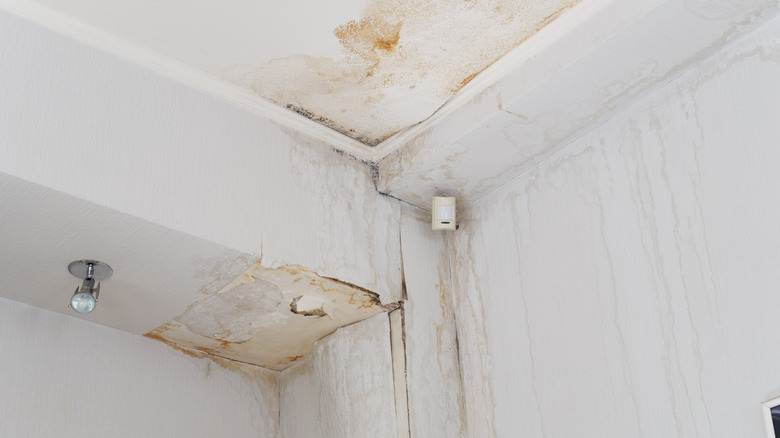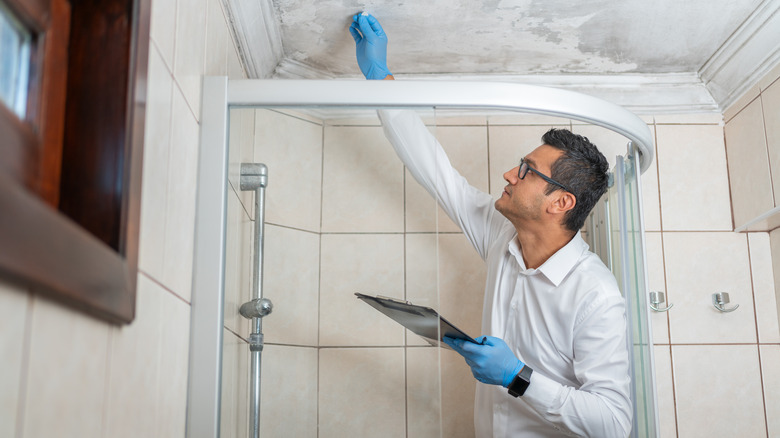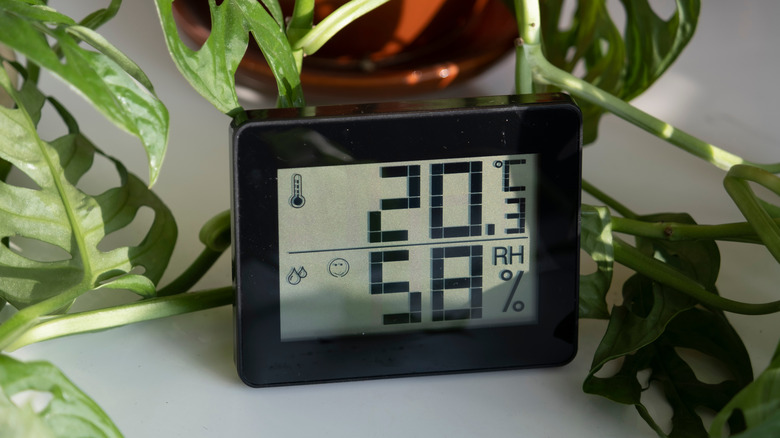Drywall Ghosting: The Unsightly Problem That Gets Mistaken For Mold
We may receive a commission on purchases made from links.
We all know the horrors that come with mold. Beyond the unsightliness of the spotty substance, it can have major effects on health, causing nasal congestion, itchy skin breakouts, wheezing fits, throat irritation, and danger to those who may have immune diseases. So if you see even the smallest amount developing, it's best to act fast. Surprisingly though, sometimes what you think is a mold problem is actually drywall ghosting, so don't grab your bleach and water concoction just yet.
Mold typically grows in a spotting pattern. If your "mold" has dark, shadowy lines tracing the ceiling or wall, it's a good tell that it's drywall ghosting, which is caused by insulation issues in your walls or ceilings. Be sure you also know the difference between this and water damage. While ghosting is often straight lines or defined blocks, hidden water damage in your home's walls often creates musty smells, staining, peeling paint or wallpaper, and even mold growth.
Drywall ghosting occurs when the insulation between the framing wood and the drywall is unbalanced. If the framing is cold from lack of insulation while the covered drywall gets warmer, condensation will grow on colder spots of the ceiling or wall. Activities like showering and cooking can create even more condensation — as can water damage. Add any type of dust or dirt accumulated by pets, shoes coming in and out of the house, and everyday cleaning, and those damp spots will begin to look, well, ghostly. Even pets' fur can add to these dark, streaky lines.
How to get rid of drywall ghosting
Once mold is completely out of the conversation, this cosmetic issue is relatively easy to get rid of. The only materials you need are soap, water, paint primer, and a fresh coat of paint for your new wall or ceiling. We recommend grabbing a soot sponge, as it's great for tough stains. Start by scrubbing the area until the dark lines are gone (or almost gone). If they're really difficult to remove, opt for a stronger cleaning agent like bleach. Once you're done cleaning, dry the area properly and prime the surface with a stain-blocking primer — like this one from Home Depot — before painting. Keep in mind that you can't simply paint over the problem and hope it goes away.
Some great solutions for preventing drywall ghosting are improving your ventilation, fixing any leaks, and reducing humidity levels in your home. Enhancing your home insulation will always work wonders, too. This will help replace cold spots, air leaks, and air movement. It'll also reduce your heat bills since you won't have to constantly turn up your thermometer in the winter due to heat loss. For those who live in a warmer climate, be sure that roof leaks are taken care of, as they can naturally elevate the humidity levels in your home. Before installing a new roof during the winter season, be sure there isn't any snow that could add to your moisture worries.
Preventative measures
There are a few preventative measures you can take to ensure drywall ghosting doesn't make a comeback in your home. As humidity is the No. 1 way to attract dampness, buying a bathroom extractor may help you out. The device gets rid of any additional moisture while you're showering or bathing, which is great if your home has poor ventilation. A simpler option is opening your windows during your showers, especially if you live in a damper, warmer climate. You should also get rid of pet fur in your home by using lint rollers and slipcovers.
If you smoke, try not to do that inside of your home — or only within a well-ventilated area. Cigarettes contain harmful chemicals, which can feed ghosting and create yellow staining on walls and ceilings. Unfortunately, burning candles does the same. In fact, any combustible liquid releases vapors that come with burning. Moving your dryer and washer can also be a big help. A lack of ventilation between these two appliances can create condensation on walls and attract dirt particles.
Grabbing a hygrometer, aka a humidity measuring tool, might be the way to go if you've done everything and want to stay on top of your home's moisture levels. According to the U.S. Environmental Protection Agency, your home's humidity levels should stay between 30% and 50%. Grab one from your local hardware store — or this one from Amazon.


